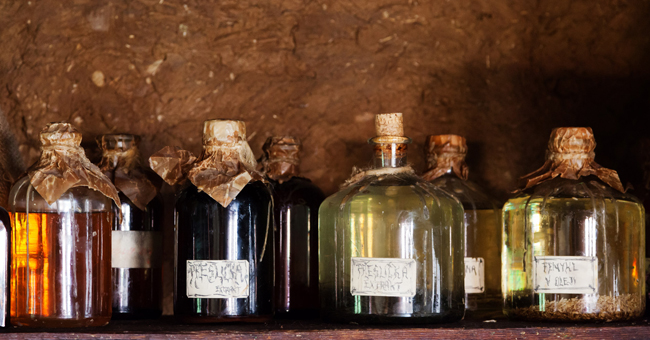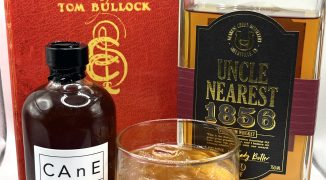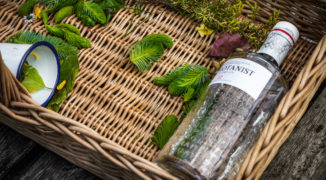When Francesco Amodeo founded Washington, D.C.’s Don Ciccio & Figli, his sights weren’t set on the District of Columbia, but rather, on Italy’s Amalfi Coast where he was raised. He hoped to bring back to life some of the wonderful flavors and ingredients of the region through liqueurs.
“The classics [in our lineup] are based on the Amalfi Coast,” said Amodeo during a recent visit and tour of his facility. “Things that were once made and produced, but never got to the general public or never were appreciated.”
There was a specific moment of inspiration when his father found an 80-year-old bottle of amaro. “The last one remaining,” Amodeo says. “I went back home just to try that, and it was still great. We kept most of the flavor there, and just had to balance it out with more botanicals.”
That historical find led directly to the creation of DCF’s Amaro Delle Sirene, which remains their flagship product. Now, there’s also a special edition of aged Sirene, two other amari, and more than half a dozen other liqueurs and aperitifs.
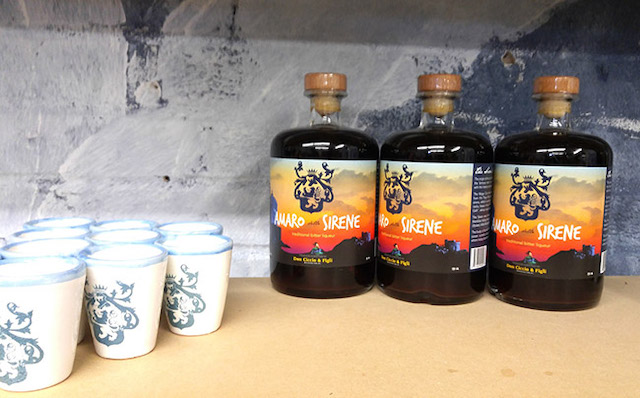 Amaro della Siren is DCF’s flagship product, inspired by Francesco Amodeo’s father finding an 80-year-old bottle of amaro from their native Amalfi Coast.
Amaro della Siren is DCF’s flagship product, inspired by Francesco Amodeo’s father finding an 80-year-old bottle of amaro from their native Amalfi Coast.
They keep one eye focused on tradition, with the other focused ahead, by following historical botanical profiles but tweaking them to their own liking. “We try to keep one of the main flavor profiles and you can detect that very easily, but it’s specific to us,” explains Amodeo.
“We practice and appreciate the tradition, and that’s what we produce, we produce traditional liqueurs with a nod to the future,” says Jonathan Fasano, the all-purpose assistente del maestro at Don Ciccio & Figli.
Cocktails are also key to everything DCF does. “Our idea is always to use things for cocktails,” says Amodeo. “Everything we do is cocktail-oriented, and everything we do is trying to figure out the flavors that are not out there yet, that we’re missing.”
Further, by buying neutral grain spirit as opposed to distilling their own, the brand more easily partners with local distilleries, as opposed to compete with them. “So we try to be different and work with any of the distilleries to make local cocktails, American-made cocktails, instead of competing by saying ‘my gin is better than yours, my rum is better than yours,'” says Amodeo.
“We’re providing domestic alternatives to imported brands that you can’t find,” says Fasano. “There are other companies making amari and aperitivos, but they’re whiskey companies and gin companies and they’re like ‘oh we’ll dabble in this.’ But this is our heart and our soul.”
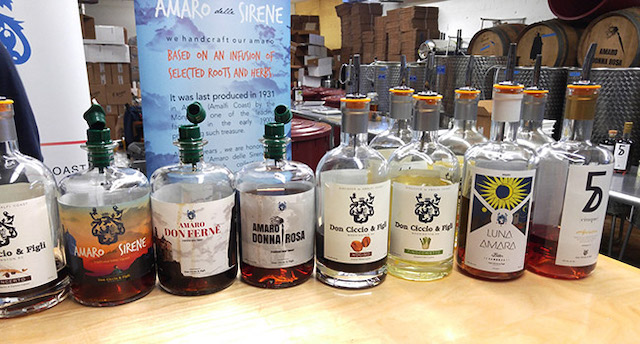 For Don Ciccio & Figli, amaros and apertifs are their bread and butter — not just a one off or half-hearted venture into a new venture.
For Don Ciccio & Figli, amaros and apertifs are their bread and butter — not just a one off or half-hearted venture into a new venture.
Making amaro
Don Ciccio & Figli will be distributed in up to 25 states by the end of the year and is looking to expand into a larger facility. But for the home practitioner or bartender looking to develop something of his or her own, amaro production can be scaled down in the other direction as well. They’ve even had customers bring in their own homemade renditions of popular DCF liqueurs, made with the help of a few pointers from Amodeo and Fasano. Here, those pointers are explored in greater detail, for a step-by-step tutorial to producing amaro.
Starting spirit
DCF starts with 190 proof neutral grain spirit made for them in Connecticut. “The highest quality spirit we can possibly get,” says Fasano. “Very clean, absolutely pure.”
Even though they’re not doing the distillation themselves, they still precisely control the spirit they receive. Per their specifications, the spirit consists mostly of corn, with a bit of malted barley, and is triple-distilled before resting for six months.
Of course, arranging for a personal neutral grain spirit supply isn’t feasible for everyone. “For people at bars or at home, you will find vodka or Everclear,” suggests Amodeo. “Everclear is very hard to bring the proof down, and you need to add a lot of sugar because it’s not top-notch.”
Vodka, though, is bottled at a lower proof and is already sweet to some degree. “You can add sugar just to counterbalance, but less sugar than you otherwise would … But you can make a pretty decent amaro,” he says.
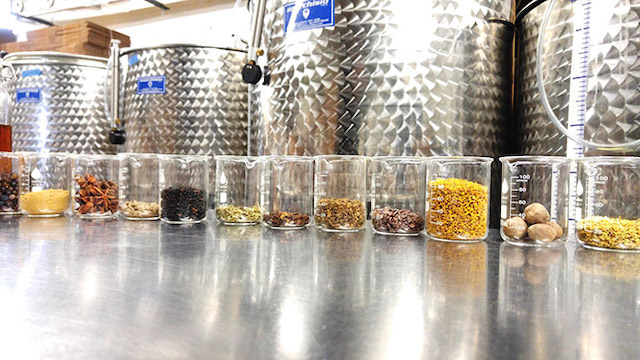 Don Ciccio & Figli begins each amaro with a foundation of 15 spices, herbs and botanicals.
Don Ciccio & Figli begins each amaro with a foundation of 15 spices, herbs and botanicals.
Spices and botanicals
Amari may contain anywhere from a handful to dozens of different spices, herbs and botanicals. At Don Ciccio & Figli, a group of 15 represents a starting base. “The core botanicals that get made into an amaro,” offers Amodeo. “If you make your amaro out of these 15 botanicals, you’d get a pretty good amaro.”
That core lineup includes: licorice, Quassia wood, cinnamon, juniper, coriander, star anise, Elecampane root, passion flower, elderberry, chicory, rhubarb, cacao, bee pollen, nutmeg and elderflower.
The amount used of each will vary in different recipes, while other botanicals may be added or subtracted. Experiment with different ratios and recipes to pin down exact flavor profiles.
While botanicals can get pricey, the good news is that they can be found online. Amodeo suggests Starwest Botanicals.
Use a gentle hand with any sugar — except in the case of rounding out something like Everclear. “We believe in sweetening the amaro with the barrel instead of adding too much sugar,” says Fasano. “A lot of the amari we come across these days are dumbed down, too viscous, where amari need to be able to express their identity.”
Let all of those hand-selected botanicals do the talking instead. Further, always emphasize natural ingredients when possible. “Instead of orange extracts … we don’t need to use that,” says Amodeo. “We’ll just boost it with the mandarin [peels].”
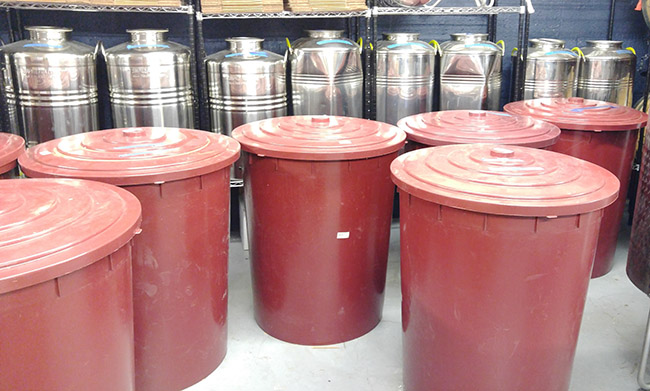 After amaros and apertifs are imbued with spices, they are macerated and filtered in tanks.
After amaros and apertifs are imbued with spices, they are macerated and filtered in tanks.
Maceration
Once spirit has been combined with spice, it’s time for maceration. “Maceration being simply the withdrawal and removal of flavors, colors and other physical properties through the liquid,” says Fasano.
While Don Ciccio & Figli macerates in 300-liter plastic tubs, regardless of batch size, maceration shouldn’t last longer than a few weeks. In many cases, as little as a week should suffice. Amodeo says this is one of the biggest mistakes he sees with amaro production. “You can’t just dump it all in there and six months later it comes out,” he says.
“It has to be in there two to three weeks tops. A lot of the recipes you find online, you see 40 days, 60 days, a year … the more you let it macerate, the worse it gets. All the flavors then start to organically flip.” As one example, cinnamon turns overly spicy, and most other botanicals begin imparting unwanted flavors as well.
Vodka will need a longer maceration time than Everclear, based on proof alone. “Vodka, you need a little more time,” says Amodeo. “Everclear, you need a very short period of time. I suggest don’t go over two weeks. It’s just too much.”
Filtration
Don Ciccio & Figli uses simple gravity-based filtration system. Post-maceration, the spirit is moved into stainless steel filtration tanks and allowed to sit for one to two weeks, with all the sediment settling on the bottom.
At home, makeshift filtering can be performed with something such as a fine sieve or strainer. After that, it’s time to proof it down. While DCF’s neutral grain spirit starts at 190 proof, and hovers closer to 180 after maceration, it goes into their barrels at 75 proof. “It just seems like the magic number for these barrels,” says Amodeo. Be sure to use purified water to cut the spirit down.
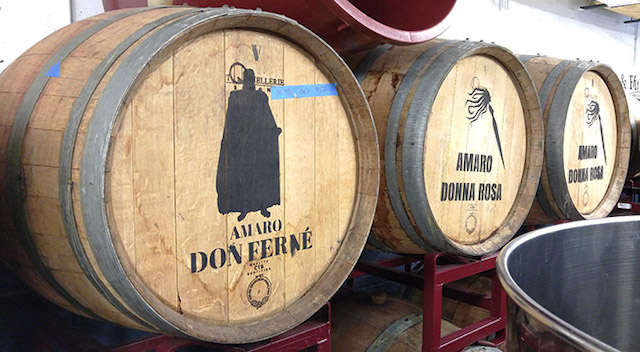 Amaro at DCF is aged in 250L ex-red wine casks for three to 12 months.
Amaro at DCF is aged in 250L ex-red wine casks for three to 12 months.
Aging
DCF uses 250-Liter ex-red wine casks, but as is the case with barrel-aged cocktails, it’s easy to find 5- or 10-Liter barrels for behind the bar aging.
How much time is spent in the barrel is dependent on desired results. DCF ages their amari anywhere from three months to 12 months. Small barrels will call for less time. Take a sample taste periodically, which also offers a chance for corrections, in case botanicals or flavors ended up out of whack. “You can correct things up until the end,” says Amodeo.
After barrel-aging, DCF further proofs down the amaro to its final bottling strength.
Additional Tips
Test Runs: “We always advise to do small test batches,” says Fasano. At DCF, such a small test was shown next to their botanicals, just perhaps half a liter of liquid in a clear jar. “To at least understand the flavor we’d like to get to.”
They may conduct 18 to 20 trials before settling on a recipe. Hands-on experimentation is always the best way to learn, and seeing clearly what doesn’t work is the key to figuring out what does.
“There’s a reason we only put five pieces of clove in the Nocino [a walnut liqueur]. Because if you go six … that’s all it needs,” says Fasano.
In other words, one extra piece of clove in 300 liters of liquid can throw off an amaro. “It’s trial and error, just make sure you have that base of bitterness, that’s going to lay the foundation for everything else you want to put on top of it.”
 When making amaro, sometimes a happy accident can yield your best product yet.
When making amaro, sometimes a happy accident can yield your best product yet.
Happy Mistakes
Of course, sometimes errors can end up quite lucky. “Sometimes we make mistakes, and the mistakes turn out to be so good. Donna Rosa is a classic example of that,” says Amodeo, referring to their new Amaro Donna Rosa. “I think I blended one of the spice packs for the Luna [Amara Bitter] inside Cinque [Aperitivo]. And it created Donna Rosa. We fixed the recipe a little bit from the mess-up one, and then we were like, we can’t not make this.”
“The wheels never stop turning,” says Fasano. “I’ll start suggesting ideas, and [Francesco’s] like ‘I’ve got enough ideas!'”
For the would-be home amaro producer, above all else, take that same experimental approach and something special just might come out of that barrel.


